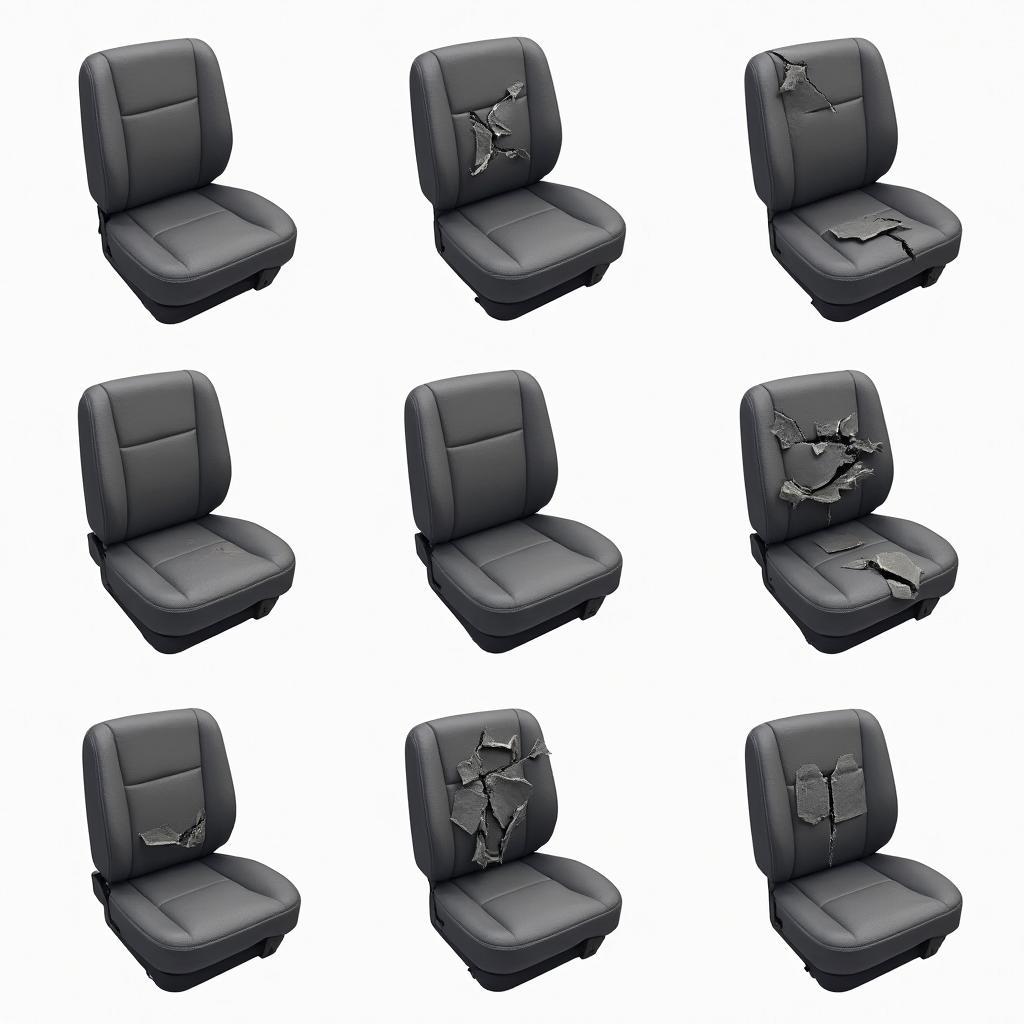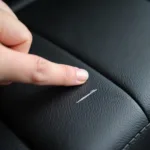Tears in your cloth car seats can be a real eyesore, detracting from the overall look of your vehicle’s interior. But fret not! Repairing these tears might be easier than you think. Whether it’s a small snag or a larger rip, this guide will equip you with the knowledge and techniques to tackle those unsightly tears and restore your car seats to their former glory.
Assessing the Damage and Gathering Supplies
Before diving into the repair process, take a moment to assess the severity of the tear. Is it a minor snag, a small rip, or a larger gash? Understanding the extent of the damage will help you determine the best repair approach.
 Types of Cloth Car Seat Tears
Types of Cloth Car Seat Tears
Once you have a clear picture of the damage, gather the necessary supplies. Here’s a basic list:
- Fabric repair kit: Choose a kit specifically designed for cloth upholstery, containing fabric patches, adhesive, and color matching options.
- Scissors: Opt for sharp fabric scissors to ensure clean cuts.
- Tweezers: Helpful for precise placement of patches and removing loose threads.
- Clean cloth: Use a lint-free cloth to clean the damaged area before applying any adhesive.
- Optional: Depending on the severity and type of tear, you might need additional items like a seam ripper, needle, and thread.
Simple Repairs for Minor Snags and Small Tears
For minor snags and small tears, a fabric repair kit usually does the trick.
- Clean the area: Gently clean the torn area with a clean cloth to remove any dirt or debris.
- Prepare the patch: Choose a fabric patch from your kit that closely matches the color and texture of your car seat’s upholstery. Cut the patch to a size slightly larger than the tear, ensuring it covers the entire damaged area.
- Apply adhesive: Apply a thin layer of adhesive to the back of the fabric patch, following the instructions provided with your repair kit.
- Position and press: Carefully position the patch over the tear, ensuring it aligns smoothly with the surrounding fabric. Use your fingers or a clean cloth to press firmly on the patch for several seconds, ensuring a strong bond.
- Let it dry: Allow the adhesive to dry completely according to the manufacturer’s instructions.
Tackling Larger Tears and Rips
Larger tears and rips require a bit more effort and might involve some sewing.
- Clean and prepare: As with minor repairs, start by cleaning the torn area thoroughly.
- Assess sewing needs: If the tear is along a seam, you might need to use a seam ripper to carefully remove the existing stitches before proceeding with the repair.
- Choose your patching method: You can opt for a fabric patch similar to the process outlined for minor tears, or you can try a “hidden patch” method. For the latter, choose a fabric that closely matches the back of your car seat’s upholstery and cut a patch slightly larger than the tear. Apply adhesive to the back of the patch and carefully slide it under the tear, ensuring it aligns with the torn edges. Press firmly to secure the patch in place.
- Sewing (if needed): If the tear is large or in a high-stress area, sewing can provide additional strength and durability. Use a curved needle and thread that closely matches the color of your car seat’s upholstery. Carefully stitch along the edges of the tear, ensuring the stitches are small and even. For a hidden patch, sew through the existing fabric and the edge of the patch underneath.
Seeking Professional Help
While DIY repairs can be effective for many cloth car seat tears, some situations might warrant professional help. Consider contacting a professional upholstery repair shop if:
- The tear is extensive or complex.
- The fabric is delicate or requires specialized knowledge.
- You’re not comfortable with sewing or using adhesives.
how to repair car leather seat tears can be just as tricky, so don’t hesitate to get professional help for those as well.
Preventing Future Tears
Prevention is always better than cure! Here are some tips to keep your cloth car seats in top shape and prevent future tears:
- Regular cleaning: Regularly vacuum and clean your car seats to remove dirt, dust, and debris that can cause wear and tear over time.
- Use seat covers: Consider using seat covers to protect your upholstery from spills, stains, and everyday wear.
- Be mindful of sharp objects: Avoid placing sharp objects on your car seats, as these can easily puncture or tear the fabric.
- Address small tears promptly: Don’t ignore minor snags or tears. Addressing them promptly can prevent them from worsening over time.
Conclusion
Repairing tears in your cloth car seats is achievable with the right approach and a little patience. By following the steps outlined in this guide, you can restore your car’s interior and enjoy a more comfortable ride. Remember, how to repair frayed car seats may require different techniques, so it’s essential to assess the damage and choose the appropriate repair method.


